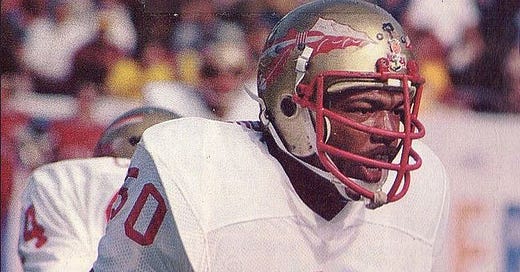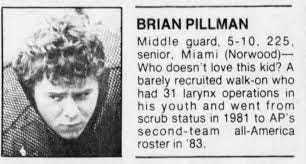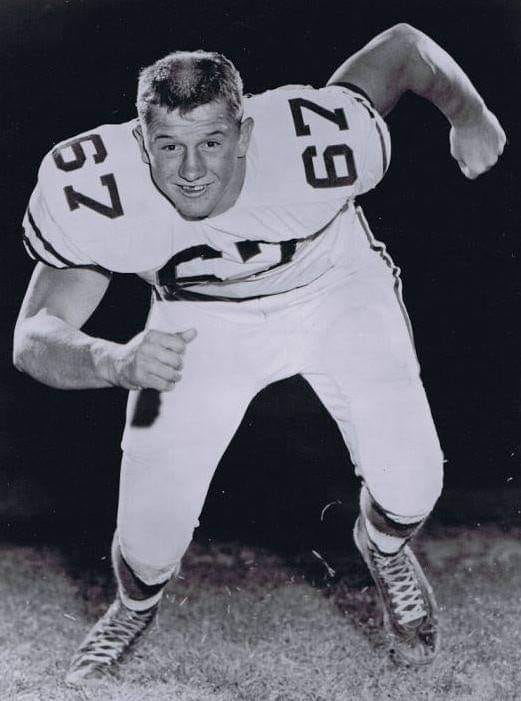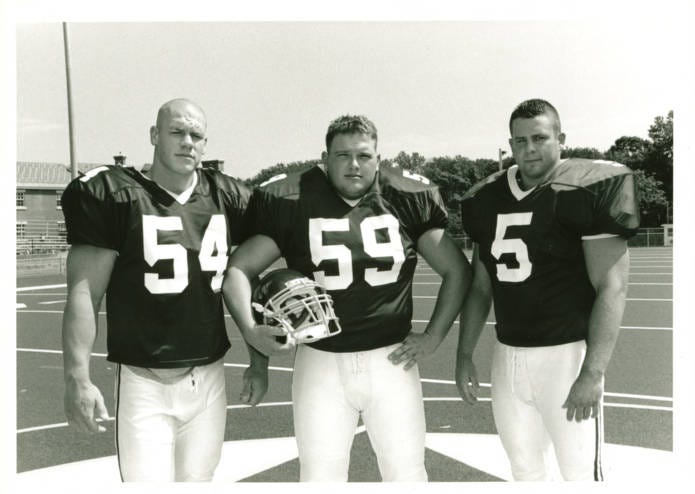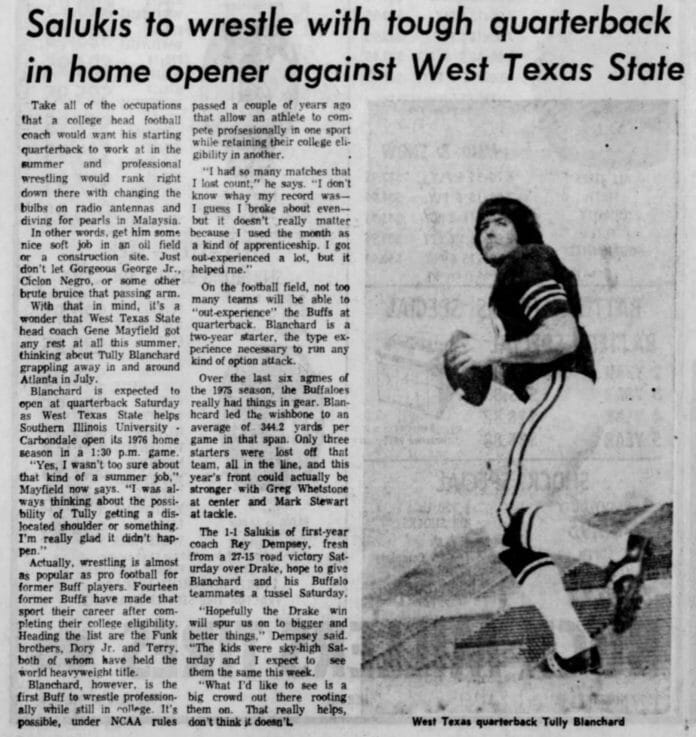Q&A: A Pro Wrestling Football Starting 11; Position Coaches as Head Coaches
It’s been too long since a Q&A edition of The Press Break Newsletter, so what better way to usher in the new month?
If you' would like to contribute your questions, just tweet me @kensing45 or @ThePressBreak. You can also email pressbreaknewsletter@gmail.com.
Let’s dive in!

This is a topic that’s long fascinated me — so much so, I have spent several years working on a specific wrestling-and-football topic I hope to compile into a book in the very near-future. For the most part, I have decided to limit this to wrestlers who did play ball, though not all at the college level.
Defensive Line
A quick intro to this position specifically: Defensive line is the toughest to narrow down because numerous college (and some pro) d-linemen have shifted effectively to the ring. Lex Luger, who played end at Miami on the same team as Mark Richt and spent some time in the CFL, is a noteworthy omission. So is current WWE Champion and former Iowa Hawkeye tackle Big E.
I attempted to narrow the group down through of a combination of in-ring and gridiron accomplishments.
Ron Simmons: A two-time All-American at Florida State, Ron Simmons is arguably the second-best football player to transition to pro graps (Bronko Nagurski will always be the benchmark). Simmons is also noteworthy as the first Black wrestler to hold the World championship of one of the major American promotions.
Roman Reigns: Before he was at the Head of the Table in WWE, Roman Reigns was an All-ACC defensive tackle at Georgia Tech.
Brian Pillman: Brian Pillman was John Harbaugh’s college roommate at Miami (OH) and an All-American nose guard — surprising, giving his size was more comparable to that of a strong safety, but a development that foreshadowed his frenetic energy in the ring.
I think it’s fair to call Pillman’s matches with Jushin Thunder Liger a precursor to present-day MACtion.
The Rock: Dwayne Johnson’s exploits on the defensive line at Miami, playing alongside Warren Sapp, are well-known. One of the coolest moments in the last decade or so of professional wrestling was in 2012, The Rock making his first entrance for a match at WrestleMania in eight years in Miami, and a fan holding up along the rampway a custom Johnson Hurricanes jersey.
Linebackers
Terry Funk: West Texas State (now A&M) boasts a rich history of football alumni turning to pro wrestling. Terry Funk is one of the most prominent in that lineage. I can imagine the reckless abandon with which he pursued tackling — and I love that even in college, he looked like his wrestling gimmick of unabashed mad man.
Dory Funk Jr.: A Hall of Fame inductee, Dory Funk Jr. was the best of the West Texas gridiron-to-squared pipeline.
Become a supporter on Patreon and read a story from an exclusive interview with West Texas alum “Million Dollar Man” Ted DiBiase.
Goldberg: While Goldberg played defensive end at Georgia, his style would translate well to linebacker.
Defensive Backs
Homicide: If you checked out AEW Rampage last Friday, you caught the debut of Homicide, a long-time veteran and one of the early stars of the 2000s independent scene. Before he became a foundational member of Ring of Honor, Homicide was a standout high school football player with college scholarship offers. I don’t know how much of it is kayfabed, like Snoop Dogg claiming to have had basketball offers from Long Beach State and UNLV in the early ‘90s, but he was alleged to have piqued the interest of Miami.
Kurt Angle: The Olympic Gold Medalist turned his attention exclusively to wrestling upon entering college, but Kurt Angle was a high school All-American at Mount Lebanon in Pennsylvania. He played linebacker at the prep level, but Angle is more the size of a defensive back. In the ring, he showed the ability to keep pace with the fastest wrestlers like Rey Mysterio, and I would task him with keeping up with wide receivers on defense.
Jimmy & Jey Uso: WWE’s standout tag team once combined forces as linebackers at Div. II West Alabama. The versatile Usos have speed and size that would translate well moving them to the safety spots.
BONUS: Offensive Players
Putting together an offensive starting 11 is a tougher task than defense, most notably at the skill positions. The physicality of defense makes for a more natural transition to professional wrestling than something like wide receiver, so I limited this side of the ball to just a few positions.
Offensive Line
Like defensive line, this is a unit that’s difficult to cut down to just five. The most noteworthy omission’s are Bob Sapp, who was part of the Whammy in Miami Washington team that ended The U’s Orange Bowl winning streak and 12 years later became IWGP Champion; and Bruiser Brody, a West Texas product who had a cup of coffee on the line of the Washington Football Team.
But here goes:
“Dr. Death” Steve Williams: The All-American wrestler also started on the Oklahoma offensive line and earned All Big 8. He played in the 1980 Orange Bowl opposite the Florida State defensive line with Ron Simmons.
Baron Corbin: Current WWE star Baron Corbin starred at guard for Div. II powerhouse Northwest Missouri and played on the Arizona Cardinals before moving to wrestling.
Vader: Leon White is one of the most accomplished football players to take up wrestling, having been an All Big 8 selection at Colorado and playing for the Los Angeles Rams before wrestling. Vader is one of two alumni from current Pac-12 programs to have won New Japan Pro Wrestling’s IWGP Heavyweight Championship, the other being Bob Sapp.
John Cena: There were more decorated linemen in wrestling than John Cena, but none made as much of an impact in the squared circle as the former Springfield College starting center. But, to be honest, I mostly included him to use this photo of him in college — he some looks exactly the same almost 25 years later, just with a full head of hair these days.
John Tenta: The man best known as Earthquake came into professional with a legitimate sports background, having played on the the offensive line at LSU — hence the tiger tattoo on his shoulder. Tenta’s best known in the sports world, however, for being a standout sumo wrestler.
The thought of a bonafide sumo pushing around defenders tickles me to no end.
Quarterback: Tully Blanchard
Another in the long line of West Texas products to move over to wrestling, Tully Blanchard was an excellent dual-threat quarterback for the Buffaloes.
Running Back: “Mr. Wonderful” Paul Orndorff
The now-defunct University of Tampa football program was a budding player on the national scene in the 1970s, peaking with a trip to the Tangerine Bowl against a Kent State team that featured Nick Saban at cornerback.
Orndorff shared the backfield with Leon McQuay Sr. Both were NFL draftees, and both were effective. Orndorff rushed for almost 1,000 yards in ‘71 and ‘72 and was an effective pass-catcher out of the Spartans backfield.
Fullback: Bron Breakker
The confounding decision of WWE producers to rename the son of Rick Steiner something other than Steiner aside, NXT newcomer Bron Breakker is destined for stardom in the ring. On the field, he was very recently a standout at fledgling FCS program Kennesaw State.
Tight End: Rob Gronkowski
I’m cheating a bit here — and by making this exception, leaving myself open to justified criticism for not including Lawrence Taylor at linebacker, given Taylor’s main-event match at WrestleMania XI — but Rob Gronkowski has enough ties to professional to make the lineup.
Gronkowski appeared in the Andre The Giant Memorial Battle Royale at WrestleMania 33, has teased getting involved in wrestling, and is close friends with former Maryland Terrapin defensive lineman-turned-pro wrestler Mojo Rawley.
The duo even appear together in the corny EDM music video “On My Mind.”

I used to think selling beer at college stadiums was a recipe for disaster. College campuses might be the locations most synonymous with binge drinking anywhere on the planet, and that can lend itself to some bad circumstances.
In particular, I compared experiences I had at college football games without beer being served to NFL stadium, where it flows freely. I have never been to an NFL game that I wasn’t working which didn’t have a fight break out. I attributed a lot of that to fans being drunk.
But as more college stadiums have embraced selling beer to counteract the growing difficulty in attracting fans — in part because being able to watch multiple games on a big screen with a fridge full of beer is more cost-effective and appealing — it hasn’t felt like college games have taken on the same Mad Max qualities that plague the bleachers of NFL games.
In fact, I’ve now come around to the opposite opinion: It’s better to serve beer and have people out of their seats for stretches because they’re at the concessions than it is for students binge-drinking before entering the stadium.

Sam Pittman’s success at Arkansas is one of the best stories of the college football season thus far, in part because his rise bucked the template for Power Five coaching success so emphatically.
Pittman seems to have an understanding of program-building specifically because his path deviated so wholly from those tabbed for immediate success. He experienced football at several different levels, having to learn to do more with less based on budgetary restrictions, then adapted accordingly once he was working with blue chips and high expectations at Georgia.
Arkansas may have an SEC budget, but it also has unique limitations in comparison to most of the rest of the conference. Pittman’s experience on two ends of the spectrum made him uniquely qualified for the job.
The current success of Pittman and, to a lesser extent, Mario Cristobal should be endorsements for position coaches earning head-coaching looks. Cristobal obviously had head-coaching experience prior to Oregon, and was promoted to head coach at Oregon from a coordinator’s position. However, he landed at FIU after coaching tight ends (including Greg Olsen!) and the offensive line at Miami and was only an offensive coordinator for a single season in the six years between his departure from FIU and tenures at Alabama and Oregon as an assistant.
I was long perplexed that Alabama colleague Lane Kiffin got so much more buzz for head-coaching vacancies than Cristobal, given the latter’s previously head-coaching tenure at FIU was comparatively more impressive than Kiffin’s at USC based on resources and what each inherited. But such is the strength of being a coordinator vs. a positions coach.
That really should change based on Pittman and Cristobal. And should positions coaches get more opportunities to jump straight into lead roles, I suspect it will continue to be offensive line coaches in the same vein as Pittman and Cristobal.
I attribute that assumption to how vital getting five players to perform in complete unison is to the OL coach’s job. Poor offensive line play is also the most difficult deficiency to mask. These qualities translate well to the expectations of a head coach’s job.

I have always loved Halloween, but especially so since becoming a parent and sharing in my children’s excitement. To that end, this year’s costume will certainly be in the running for my best ever: I am dressing as Wario, keeping with a family theme in which my wife and two-month-old daughter are Princesses Peach and Daisy; my 3-year-old is Mario; and my 7-year-old is Luigi.
The other peak in my love for Halloween was college. It’s the ultimate college-kid holiday, a built-in excuse to party-hop for the night. Mean Girls was extremely on-point in its depiction of the teen/early 20s view of Halloween.
I had a few great costumes in college, but the best was legendary Chicago Cubs broadcaster Harry Caray. The folks who knew who that was popped huge for that one.

Since we kicked off this edition of Q&A with wrestling, it seems fitting to end on that note.
The time-limit draw is a booking gimmick that should be used sparingly — and yet, at the same time, hasn’t been used enough in mainstream American wrestling. AEW going to the well for Bryan Danielson-Kenny Omega was perfect.
One of my favorite time-limit draws that wasn’t quite perfect is Ric Flair vs. Sting from the first Clash of the Champions. The match itself is outstanding, and as Sting’s first World title bout, solidified the young up-and-comer as a superstar.
However, the WCW booking committee wanted to include celebrities in the main event and thus had a judges panel that included Eddie Haskel and annoying bozo Jason Hervey to render a decision.
Years later, Ring of Honor used the time-limit draw to add tension to the lengthy title reign of Samoa Joe in 2004. Joe was an indestructible force who held the promotion’s top belt for almost two years, dominating all challenges — expect one. CM Punk took Joe to a pair of time-limit draws on cards appropriately named Joe vs. Punk I and Joe vs. Punk II.
A well-booked time-limit draw can enhance a rivalry, as was the case for Samoa Joe and CM Punk. Wrestling arguably has no rivalry better in the last 20 years than Kazuchika Okada-Hiroshi Tanahashi, who have put on some of the greatest matches of all-time.
Among them is their 30-minute draw in the 2018 G1 Climax.
The G1 is the ideal format for a draw, because every match is 30 minutes long, and a draw isn’t a simple tie in the context of the tournament. A G1 draw can determine who advances to the month-long event’s final, as was the case for the 2018 Okada-Tanahashi matchup. Okada needed a win to claim the block; a draw would send Tanahashi to the final.
I’ll go so far as to call this my favorite time-limit draw in wrestling history, but it gets a run for its money from Okada vs. Minoru Suzuki the year prior in G1 Climax 27.

